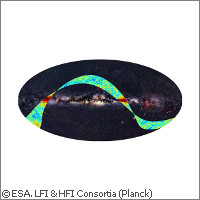Secrets of the Big Bang universe revealed by relic radiation images
The Planck satellite observatory has successfully completed its two-week survey of the sky, and has delivered observations of our Galaxy's microwave background radiation with unprecedented sensitivity and detail. The new information can be used by cosmologists and astrophysicists to more precisely calculate details about the age and composition of the Universe. The Planck satellite was launched on 14 May along with the Herschel observatory from Kourou, French Guiana on an Ariane 5 rocket, and it reached its observation point (around 1 million miles from Earth) 6 weeks later. Herschel and Planck are both important missions supported by the European Space Agency (ESA) as well as academic institutions and industrial consortia. The Plank telescope is highly sensitive to temperature variations of a few millionths of a degree. Because of its unique instrumentation (i.e. its Low-Frequency Instrument and High-Frequency Instrument), it can measure fluctuations in the Cosmic Background radiation (CMB) with unprecedented accuracy. The Low-Frequency Instrument is made up of 22 tuned radio receivers located in the focal plane of the Planck telescope. The High-Frequency Instrument features 52 'bolometric' detectors (which measure radiant energy) placed in the focal plane of the telescope. This allows for imaging the sky at different frequencies between 100 GHz and 857 GHz. The design and construction of both instruments are a result of international collaboration between scientists and engineers throughout Europe and in the US. The results of Planck's two-week continuous observation of the skies were highly detailed images of the early Universe. Nine maps were produced: one for each of Planck's frequencies. By observing at several frequencies, Planck can separate the CMB from the light emitted by the Galaxy at the same frequencies. As a result, the observatory can detect and characterise both gas and dust, and the maps produced at nine different frequencies allow individual sources of microwave light to be distinguished on an unparalleled scale. Professor Richard Davis of Manchester University in the UK, a leader in the development of Planck's Low Frequency Instrument, commented: 'In the 16 years since Planck's development started, this is the most exciting time. The wonderful thing is that Planck, from its vantage point one million miles from Earth, is now producing images of the creation of the Universe, the so-called Big Bang, with a clarity never seen by mankind.' Plank was designed to operate for 15 months, during which it will gather data for two independent 'all-sky' maps. Researchers now have a rare opportunity to analyse the vast amount of data on the early Universe collected by Planck's highly sensitive instrumentation; future missions are expected to further illuminate our understanding of the cosmos.
Countries
United Kingdom



